ENNS OF AN ERA
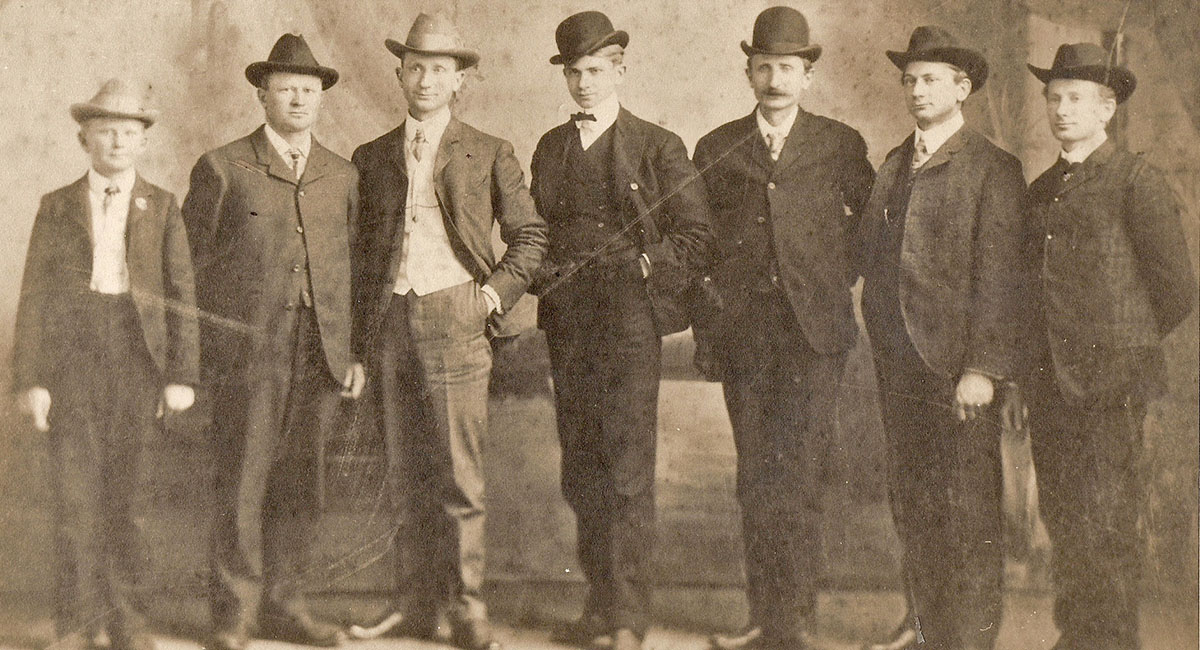
Publisher Gregory Enns retraces his family’s arrival in Fort Pierce from Kansas exactly 100 years ago
BY GREGORY ENNS
They traveled from the valleys of Prussia to the steppes of Russia, the wheat fields of Kansas and, finally, to the citrus rows of Florida.
The precise reason for the Enns family’s move to Florida is lost to the memories of those who have long since passed, but it resulted in the creation of a citrus grove, construction of a development called Maravilla and the purchase of the local newspaper.
Looking for answers to the question of why they moved is occasioned by the 100th anniversary of the Enns family’s arrival to Fort Pierce from Kansas in 1923.
Read more about the Enns family’s journey to America from Russia and their early days in Kansas.
FLORIDA PURCHASE ANNOUNCED
The Ennses’ departure for Florida was marked with a simple announcement April 23, 1923, in the Inman Review newspaper in their hometown of Inman, Kansas, where the family had arrived in 1879 and began raising cattle, growing wheat and later running a flour mill. The newspaper, quoting chief family financier John Enns, reported that the family had just purchased land in Fort Pierce to create a citrus grove.
“Mr. Enns speaks very highly of this country and thinks with proper care the land can be made very productive,” said the announcement in the Inman Review. “The land that they purchased will have to be cleared and it is expected that N.F. Enns and Elmer Enns will go there soon to look after this work.”
John had just returned from a visit to Fort Pierce about a week earlier and must have liked what he saw. He certainly had the means to invest. He was president of the Farmers State Bank and president of the family enterprise, Enns Milling Co., which had been infused with cash from wheat and flour contracts from World War I.
The N.F. Enns mentioned in the 1923 newspaper announcement was Nick Enns, John’s youngest brother. John, 44, and Nick, 33, were two of the nine sons of Cornelius and Elizabeth Enns, Mennonites who had emigrated from Gnadenfeld, South Russia [now Ukraine] in 1879. At the time of their immigration, Cornelius and Elizabeth had six sons who would have faced the prospect of military service, counter to their pacifist religious beliefs. Their other three sons were born after their arrival in the United States.
The Elmer Enns mentioned in the Inman Review announcement was my grandfather, Elmer Rowland “Putz” Enns, 22, the son of their brother, Abraham Cornelius, who had died in 1901 when my grandfather was an infant. Putz was close to getting a college diploma but opted for the Florida adventure instead of graduating.
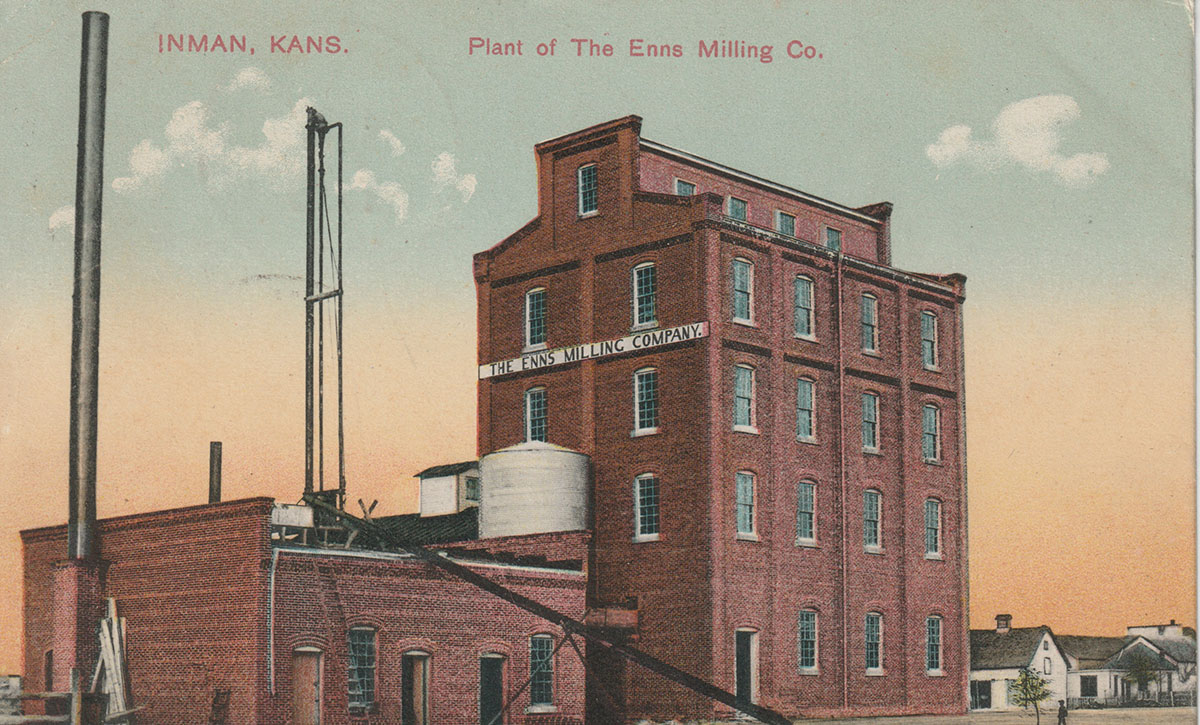
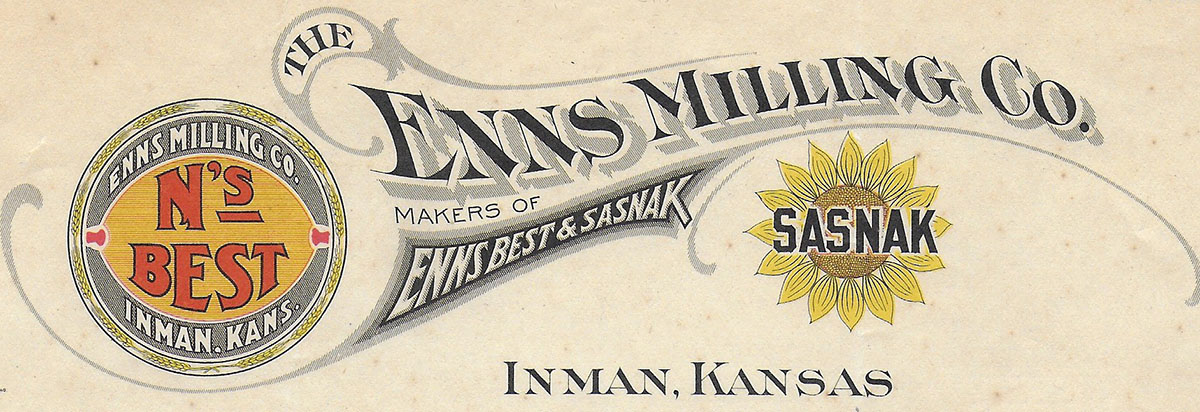
BROTHER BEHIND THE SCENES
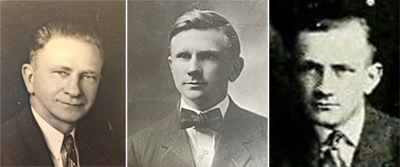
One name not mentioned in the Inman Review article was that of Paul Enns, brother of John and Nick. Paul, 38, was likely the architect of the family’s expansion to Florida and would make the move with Nick and Putz later in the year. Perhaps Paul was working behind the scenes and for competitive reasons his participation in the move was not disclosed. He also had a good banking job in Kansas City and probably hadn’t informed his bosses yet of his plans.
Paul had undoubtedly accompanied John to Florida on the April 1923 trip, with the Inman Review reporting that John had stopped in Kansas City before heading down “on a land inspection trip.”
Paul had grown up in Inman, attended Fairmont College, now part of Wichita State University, and after school moved to Kansas City to work as a banker. At First National Bank of Kansas City, two of his fellow employees were Harry S Truman and Roy Disney, who had backgrounds similar to Paul and had grown up on farms in Missouri.
Paul would later say that he didn’t agree with Truman’s politics, but voted for him once so that in case he ever saw Truman again, “I could tell him truthfully that I had.”
Of Disney, he could boast that he had beat him and his brother, Walt, to Florida by a half century. And like the Disneys, who created Main Street USA at their tourist parks as an idealized version of their childhood hometown of Marceline, Missouri, Paul had a dream of creating a model community based on his experiences growing up in Inman.
An inveterate newspaper reader, Paul undoubtedly saw the full-page ad on Page 36 of the Sept. 3, 1922, edition of the Kansas City Star. In the ad, a man named Jimmie Welch gave a testimonial about a place called Fort Pierce, Florida, where you could buy 40 acres, build a home and earn as much as $800 an acre from growing vegetables and $1,000 an acre from growing citrus. Welch’s testimonial made Fort Pierce sound like front-porch America with a rural twist.
The ad excoriated places “where pavements were hot and no place [is] provided for the children to play.” It described homes surrounded by big trees where “fresh air, pure water and sunshine were the rule and not the exception.” The ad was taken out by a concern called the Indian River Community, which also ran classifieds in Kansas newspapers recruiting people to take an excursion to visit Fort Pierce and “inspect the best 20,000 acres in Florida.” The ad also invited Star readers to visit an office in the New York Life Building in downtown Kansas City that week to learn more about Fort Pierce. Did Paul perhaps visit the office and come up with a plan to create his own Florida development?
The ads were just a few of many similar ones appearing in papers nationwide during what became known as the Florida Land Boom of the 1920s. With the arrival of the railway a quarter century earlier, improved roads and more disposable income to buy cars and real estate, more people were seeing the wonders and future of semi-tropical Florida. A rush to buy land was on.
Paul, a devoted golfer, also would have seen dispatches about Fort Pierce in February 1921, when then President-elect Warren Harding came down the Indian River aboard his houseboat Victoria to play a round of golf in Fort Pierce before heading to Palm Beach. Later, as president, Harding returned to Fort Pierce in March 1923, just weeks before the Enns scouting mission, to play another round of golf. Hitting the links in the winter and playing year-round must have been appealing to a Midwest golfer like Paul, who was limited to playing in the good-weather months.
A LONG JOURNEY
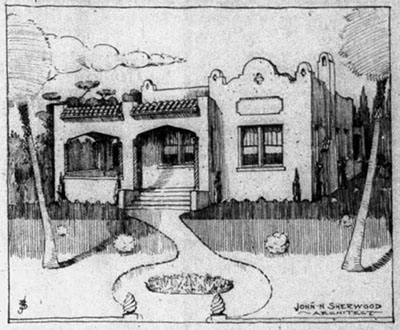
The exact date of the arrival of Paul, Nick and Putz Enns to Fort Pierce in 1923 is unknown, but it was likely after June 1923 and before October 1923, a time when there was a hiatus of their names appearing in the Kansas or Fort Pierce papers.
That brothers Paul and Nick teamed up to move to Florida is not surprising. They were the two youngest brothers and, along with brother Jacob, who became a physician in the nearby town of Newton, were the only ones born in the United States.
Their parents were Cornelius and Elizabeth Martens Enns, whose ancestors in the century before their U.S. migration had moved to Russia at the invitation of Catherine the Great. The colony in which they lived consisted of German Mennonites who had come from West Prussia [modern Poland] and were given 165 acres of land by Catherine and the promise that they would never have to serve in the Russian military.
With the grant of home rule and other special privileges, the Ennses lived in Russia for nearly a century, free to practice their religion and maintain their cultural customs. Home rule had allowed them and others to create insular Mennonite villages, forming their own local governments and overseeing the education of their children. Speaking their own Plautdietsch, the Low German dialect spoken by Mennonites, they had little assimilation with Russians and enjoyed a better standard of living than the Russian serfs.
In an effort to improve the life of the serfs, Czar Alexander II in the 1870s removed many of the privileges that emigrants such as the Mennonites enjoyed, including the exemption from military service, which prompted the Enns migration to the United States
The Enns family presumably originated from the town of Enns, Austria’s oldest city and located on the Enns River. With Austria under the Catholic Hapsburgs who fought the Reformation beginning in 1517, many Anabaptists — people who believed in voluntary adult baptism — such as Mennonites were expelled from or left Austria.
TEAM OF BROTHERS
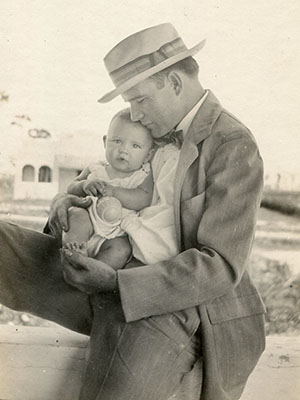
The Enns family had migration in its soul, and several of the brothers alighted out of Inman to other places in the Midwest. But the move to Florida by Paul and Nick was the family’s farthest from their Inman base.
Paul’s and Nick’s personalities couldn’t be more distinct. Paul was fastidious, cerebral, reserved and self-disciplined. Nick, a former standout football player for the Kansas State Aggies and a hometown hero, was a hail-fellow-well-met who was more impulsive and liked a good drink or two.
The first Enns’ name to appear in the Fort Pierce News-Tribune was Paul’s, with the announcement on Nov. 2, 1923, that he was beginning construction of a housing development south of Fort Pierce.
Plans at the new development called for grading the road that would become Sunrise Boulevard and building Spanish-style bungalows on 100-foot frontage lots that would average two acres each. “These homes will be offered upon the usual partial payment terms so as to enable those who have but a small amount to pay to secure one and pay the balance in monthly installments,” the article stated.
The 400-acre development was initially called the Enns subdivision but by February 1924, when it was announced that 10 homes had been built and another 10 were on the way, it had a name: Maravilla, a Spanish word that means wonderful.
Paul, once a staid banker more comfortable behind the scenes, was now front and center in the public as Maravilla’s chief pitchman. By the end of Marvilla’s first year of construction he boasted that the rate of construction was one home per week.
Designer of the model bungalows was architect John Sherwood, who had also designed the mammoth 1,300-seat Sunrise Theatre, a Mediterranean Revival-style building that had just opened a few months earlier in August 1923. The bungalows were typically Spanish Colonial Revival — less ornate than Mediterranean Revival — and were covered in stucco with arches and barrel tile roofs.
Paul touted Maravilla as an exclusive subdivision with deed restrictions that included setback requirements, construction cost minimums and the use of Spanish-style design. Publicity about Maravilla also boasted of improvements in the community, with one newspaper update noting that oil would be coated on Sunrise Boulevard, then a dirt road, to reduce dust from kicking up. Sunrise Boulevard was named after Fort Pierce’s recently acquired nickname, “The Sunrise City.” The name, suggested by Mrs. N.F. [Anna Mae] Holmes, was picked in a nickname-the-city-contest held by the News-Tribune in May 1923. Holmes won $15 for her efforts. Other entries included “the inlet city,’’ “the progressive city,’’ “the citrus city’’ and “city of opportunities.’’
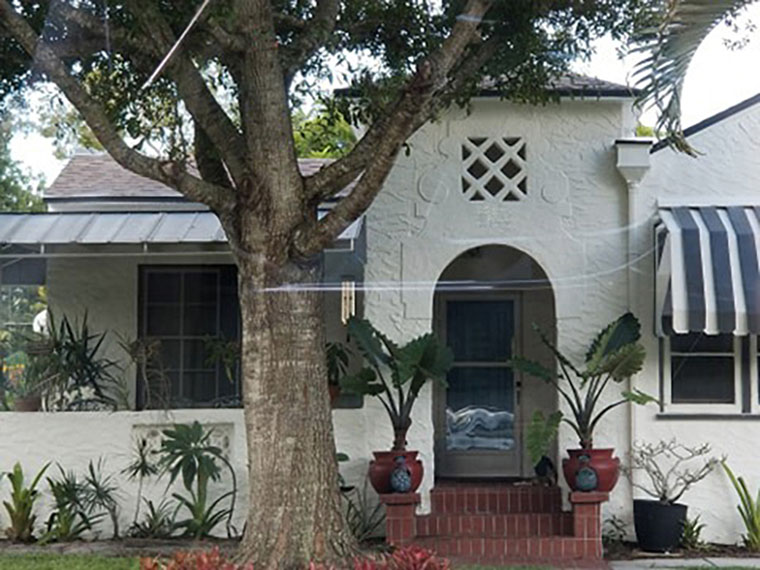
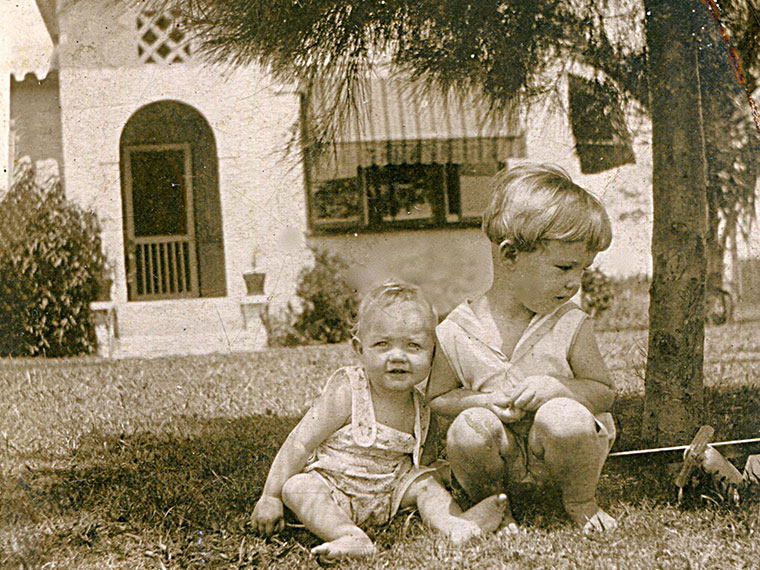
OTHER INTERESTS
To sell their lots and homes, Nick and Paul formed the Keystone Realty Company, whose tagline was “Founders of Maravilla.” L.W. Halbe, head of the trust department at First National Bank of Kansas City and a co-worker of Paul’s there, moved to Fort Pierce with his wife in October 1924 and joined Keystone Realty and Maravilla as an investor. Keystone advertisements listed Paul as president, Nick as vice president and Halbe as secretary. Paul and Halbe also formed Fort Pierce Building and Loan, which used money from local investors to provide financing to homebuyers.
By the summer of 1924, Maravilla was on the way to becoming the model community Paul had envisioned. A concrete arch gateway was erected over Sunrise Boulevard at the Maravilla entrance at present-day Virginia Avenue. Promotions pushed by Paul made Maravilla sound like a picture-perfect community. In a blurb headlined “Maravilla the Beautiful,’’ the News-Tribune described Maravilla as “pretty well-kept yards with large beds of beautiful flowers, green lawns and sidewalks, surround the attractive Spanish style bungalows at Maravilla, Fort Pierce’s exclusive residential district.”
Maravilla’s crown jewel would be a 9-hole golf course, which was under construction in September 1924. When completed a few months later, the new amenity helped distinguish Maravilla from the others Paul and Halbe were competing against and would make it one of South Florida’s first golf course communities. Paul became ever-present on the golf course and at one time was playing 72 holes a week.
Also in September, it was announced that an independent basketball team called Maravilla and backed by Keystone Realty was being formed to represent the city of Fort Pierce. Players on the Maravilla team, identified as former high school and basketball stars, included Putz Enns, Swede Hellstrom, George Gortner, Al Gordy, Corney van der Lugt and Joe Jackson.
“Putz Enns was playing on the Fort Pierce basketball team when I came to this county fifty years ago,” the late Florida Supreme Court Justice Alto Lee Adams wrote in his 1976 memoir, The Fourth Quarter. “Fort Pierce had a very fine semipro basketball team.’’
Adams, incidentally, and wife, Carra, lived at Maravilla shortly after arriving in Fort Pierce in 1924. Both their children, Alto Lee “Bud’’ Adams Jr. and Elaine, were born during the Adamses years in Maravilla.
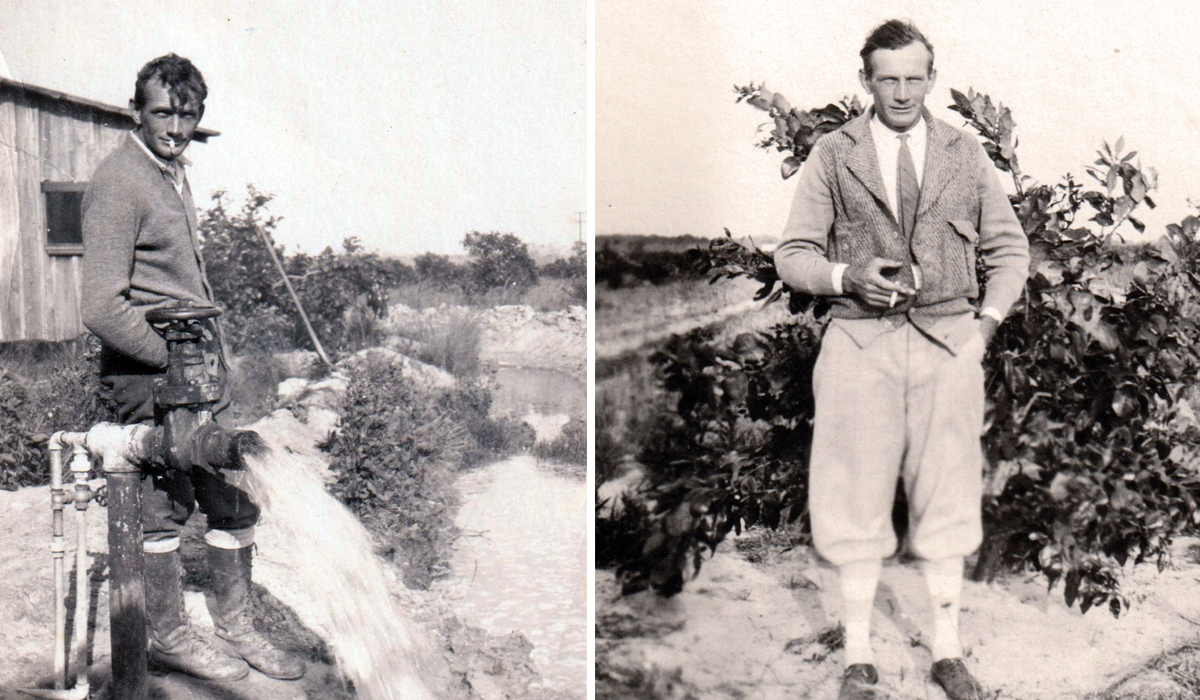
ANOTHER COMPANY
In 1925, Paul Enns and L.W. Halbe formed another real estate agency, the Enns-Halbe Company. Their Keystone Realty company would continue to focus on real estate sales at Maravilla while Enns-Halbe would handle sales elsewhere in the region. While Paul and Halbe focused on the success of the Maravilla development, Nick and his assistant, Putz, were at work developing an 80-acre grove at 10 Mile, an area approximately 10 miles southwest of downtown Fort Pierce.
The family’s switch from raising wheat to growing fruit wasn’t too far fetched, with many of Nick and Paul’s older brothers recalling the beautiful orchards owned by their maternal grandfather, Abraham Martens, in Landskrone, Russia. “Grandfather Abe Martens’ orchard with its cherries, apples, pears, plus, etc., was our paradise,” their older brother, Cornelius, wrote in 1937.
Building the grove, which was at the intersection of Midway Road and Shinn Road, must have been difficult work for Putz, the project’s chief laborer. It required clearing the acreage of thick Florida underbrush and removing stumps, grading rows for the trees and digging wells and irrigation ditches. The family operated the grove under a company called the Enns Development Association. Nick and Paul both had houses at Maravilla while Putz lived in a house on the grove. Halbe also lived at Maravilla.
TRAGEDY AND CELEBRATION
The Florida land boom was trending toward its peak as 1925 approached and all seemed to be going well for the newcomers. But tragedy struck that April when Nick’s wife, Martha, 36, died at their home of myocarditis, an inflammatory disease of the heart. Martha had grown up in Inman, graduated from the University of Kansas and married Nick in 1917. They had a daughter, Kathryn “Cash,’’ who was 6 at the time of her mother’s death. Nick and daughter traveled to Inman for the burial and returned in July. Kathryn would spend much of her childhood between Fort Pierce with Nick and relatives back in Inman.
The year 1926 was more celebratory for the family. After clearing land for planting the citrus grove, Putz began buying young trees from Robert Reed Gladwin, a citrus grower at Fort Pierce Farms north of Fort Pierce. Gladwin especially prized his China honey oranges, larger than popular honeybells and with a looser peel that made shipping them impractical.
During the visits to do business with Gladwin, a county commissioner and former Fort Pierce mayor who had arrived in Fort Pierce in 1901, Putz got to know Gladwin’s daughter, Margaret, a teacher at the Fort Pierce Farms School, now known as Indrio Road Schoolhouse. Putz, 26, and Margaret, 24, married Nov. 12, 1926, and the following August became parents of my dad, Robert Nicholas Enns.
The baby’s first name was in honor of Margaret’s father and the baby’s middle name was in honor of Nick Enns. Growing up without a father, Putz had seven paternal uncles he could look up to, and he became closest to Nick. Sadly, one uncle, Herman, had been committed to an asylum in 1892, where he stayed until his death at 63 in 1931.
Rather than uncle and nephew, Putz and Nick were really more like brothers, with just 10 years separating them in age. Putz followed Nick at Kansas State, joined Beta Theta Pi, whose chapter at Kansas State Nick founded, and tried to follow in Nick’s athletic footsteps. But he never played football at Kansas State, which he left his senior year to play football at McPherson College.
PAUL GETS MARRIED, TOO
Putz wasn’t the only Enns who found a mate in Florida. A few years after arriving in Fort Pierce, Paul, seemingly a confirmed bachelor, met Helen Groh, secretary for young lawyer Alto Adams, the future state Supreme Court justice. Helen also shared Paul’s passion for golf.
Helen was previously married and in 1926, with her mother, Natalie T. Scott, and 9-year-old son, Harkless, moved from Kansas City to Fort Pierce, where her brothers Clifford Scott, manager of the New Fort Pierce Hotel, and Karl Scott, an auditor for the St. Lucie County Bank, lived.
Even though Paul and Helen later learned they lived a few blocks from each other in Kansas City, they did not know it at the time and their meeting in Fort Pierce was their first.
Paul, 44, and Helen, 34, married in West Palm Beach on March 30, 1929, and lived at a new home in Maravilla. Paul later adopted Harkless, known as Harkie. He would graduate from the Georgia Military Academy in 1937 and go on to pilot a B-17 Flying Fortress in the 384th Bomber Group in World War II and earn the Air Medal for meritorious achievement in combat.
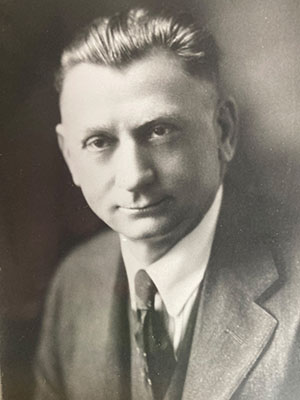
THINGS GO SOUTH
While Nick and Putz got the grove up and running, there were problems at Maravilla. The subdivision enjoyed strong sales in 1924 and 1925, but they began to drop in 1926, as Florida’s Land Boom began to go bust.
The favorable national press that Florida enjoyed in the early 1920s began turning negative in 1925 as newspapers reported on IRS investigations and land fraud cases, with Forbes magazine reporting that land prices were based on the expectation of finding customers and not on actual land value. Over-ordering of building supplies to construct new homes had choked the rail system to a point that the big three rail lines in October 1925 imposed an embargo on bringing in building supplies and limiting cargo coming into Florida to essentials such as food and fuel.
The railroads lifted the embargo in May 1926, but by then the need for building supplies had cooled. The death and devastation caused by the Great Miami Hurricane of September 1926 exposed the downside of living in Florida and shattered its blustery image as a tropical paradise. Would-be investors, once brought by the trainload to Florida, slowed to a trickle. Land prices dropped precipitously, putting mortgagees underwater and mortgage holders at risk, as many of the people who had already invested in land quit making payments and walked away from their purchases. Florida was fully three years ahead of the nationwide Great Depression that would begin in 1929.
The completion of the golf course at Maravilla by Paul and partner Halbe and the paving of Sunrise Boulevard did little to improve sales.
The situation got so worrisome that Paul’s brother, John, a major backer in Maravilla and the grove, traveled from Inman in 1927 to assess the situation. He was quoted in the newspaper as lamenting “the present quietness which is prevalent throughout most of the state.” John was considered the financial whiz of the family, purchasing a farm as a teen and paying it off by 19 and then seeing Enns Milling through the profitable World War I years.
But with Maravilla and the current situation in Florida, he must have been nervous, for much of his own money and perhaps that of Farmers State Bank in Inman, where he was president, was at risk, as the Florida land bust hit a major blow to the national banking industry.
A NEW INTEREST
Nevertheless, despite the economic downturn, Paul and Halbe expanded their holdings.
In 1926, they became investors in the local News-Tribune. Apparently frustrated with out-of-town ownership of the paper, they and some 40 other investors led by St. Lucie County Commission chairman and future state Sen. C.F. “Frank” Raulerson bought the paper from a group led by L.P. Artman of Key West.
The history of the newspaper dates to Dec. 11, 1903, two years after Fort Pierce’s incorporation, when Charles E. Emerson began publishing the Fort Pierce News. On July 21, 1905, another newspaper, the St. Lucie County News founded by A.K. Wilson, began publishing. That a town with a population of barely 500 at the turn of the century had two newspapers was rather exceptional. The two newspapers battled it out until March 1, 1920, when they merged to become the News-Tribune, with offices and its printing press at Atlantic Avenue in downtown.
The 1926 investors who sought to bring the newspaper back to local ownership read like a Who’s Who of Fort Pierce at the time and also included Crayola founder Edwin Binney, who had retired to Fort Pierce after first visiting in 1911, rancher Lin Carlton and attorneys Alto Adams and Fred Fee.
Paul’s nephew, H.T. Enns Jr., known as Ted or Heinie, was also listed as an investor and secretary of the newspaper, with Raulerson listed as chairman. Ted Enns had arrived in 1924 after the initial trip and had been selling real estate with the Enns-Halbe agency. A Kansas State graduate who also followed Nick at Beta Theta Pi, Ted would leave Fort Pierce and the paper around 1928, but later return to play a major role.
THE BUST YEARS
A challenging business environment also didn’t deter Paul from running for a seat on the Fort Pierce City Commission in 1927 against incumbent J.A. McNeil. Paul would later recall that as the votes cast in the race were counted the night of Jan. 9, the lights suddenly went out at City Hall and when they went back on his opponent was announced the winner by one vote. It was Paul’s only attempt at politics.
Meanwhile, economic conditions in Fort Pierce continued to deteriorate. When the St. Lucie County Bank reached near collapse in 1929, Binney stepped in with enough of his own money to keep it open. With the stock market crash in the fall of 1929, the Great Depression was on.
Despite hundreds of other developers in Florida going out of business during the bust, Maravilla remained viable. Reducing one of the development’s expenses, Paul had successfully persuaded the city to lease and run the Maravilla golf course. But the city in 1930, facing its own financial challenges, asked that the lease be canceled. Paul refused the request, and in a letter to city commissioners claimed that neither the golf course nor the Maravilla development had ever made its investors any money.
“The adjoining subdivision was built at a heavy loss to the owners, and likewise the golf course represents a large direct cash expenditure on the part of the owners without profit,” he wrote city commissioners.
The statement represented one of the last he would make about Maravilla, as his interests and those of his family shifted more to the newspaper business. While later News-Tribune accounts reported that Paul and Nick purchased the paper in 1929, it wasn’t until the spring of 1930 that the new ownership structure under the Enns family was revealed.
Just one month after the News-Tribune had its annual stockholders meeting in January 1930, brother John made another visit to Fort Pierce from Kansas. By April of that year, the paper’s annual statement of circulation listed John and Nick as the new owners of the newspaper, along with Halbe, who became the paper’s business manager. Also listed as owners were companies called News Investment Company and News Printing Company, which presumably represented Paul’s interests.
Perhaps it was peopled with too many Ennses, but by August 1930 Halbe had sold his newspaper interest to Harlow C. Enns, another nephew of Nick and Paul and son of John. Harlow had visited Fort Pierce in 1924 as a young man and later graduated from Kansas State, where he studied business and journalism.
“Mr. Halbe has been connected with the News-Tribune since March 1, this year, and will now devote his time to other business interests, effective today, while Paul G. Enns, with whom he has been associated, will take an active interest in the paper,’’ the Aug. 20 announcement stated.
ENNS CONTROL
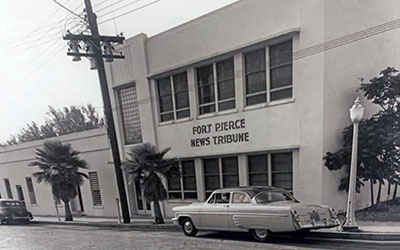
Jim Halbe, son of L.W. Halbe, once told me that economic conditions in Fort Pierce had gotten so frightful in that period that his father and Paul had simply agreed that Halbe should continue as developer of Maravilla while Paul would run and own the paper. Jim, a newspaper editor who returned to Fort Pierce and worked briefly at the News-Tribune after his father’s death in 1981, said Paul turned over his Maravilla interests to his father while his father turned over his newspaper interests to Paul. Keystone Realty was no more and the Enns-Halbe agency simply became the Halbe agency.
Hence, from late 1930 Paul’s focus was not on Maravilla, the ideal community he envisioned and that prompted his move to Florida, but on his adopted town’s newspaper, where he would serve in various roles as owner, business manager or publisher for the next 30 years.
Instead of the reluctant front-and-center impresario that Paul had become for Maravilla, he would return to his more staid banker days working more behind the scenes and running numbers. His reluctance to be the newspaper’s front man is bolstered by the fact that for the next 13 years the paper had nobody on staff with the title publisher, just Paul as business manager. It wasn’t until 1943 that Paul gave himself the title publisher.
Paul and Nick were comfortable with newspapers. Their oldest brother, Cornelius, had owned and run the Inman Review from 1902 to 1910. They had become adept at getting their own names in the paper, judging from the hundreds of times their names appeared during the first two decades of the 20th century.
At a time when the use of telephones was not widespread, getting publicity required dropping into the newspaper office and giving the editor updates about what you were doing. These self-reported news snippets, often appearing on the front page as only a sentence or two, were virtually the social media of the day.
Paul had used this to his advantage in promoting himself and Maravilla, providing updates to the newspaper at every step along the way. As the developer of Maravilla and one of the newspaper’s biggest advertisers, he also had become intimately familiar with how advertising worked and understood that advertising revenue was the lifeblood of the newspaper business.
The News-Tribune in 1930 had remarkable market penetration and was really the only local media of the day, with no radio or television station established yet. Fort Pierce’s first radio station, WIRA, wouldn’t go on air until 1946 and its first television station, WTVX, wouldn’t begin broadcasting until 1965.
Although the 6-day a week News-Tribune reported a circulation of just 1,422 in 1930, Fort Pierce’s population at the time was only 4,803. With a national average of four people in a household in 1930, the circulation figures indicated that every household in Fort Pierce and then some were receiving the News-Tribune. Under Paul’s leadership, the afternoon newspaper’s circulation doubled to 2,905 by 1940.
Throughout the 1930s and early 1940s, the newspaper’s ownership structure remained relatively the same, with Paul as business manager and other owners listed as Nick and John. Helen Enns, Paul’s wife, was listed as an owner of the paper as well, apparently replacing the interests of Harlow Enns, who had moved from Fort Pierce.
Harlow and H.T. Enns, both of whom arrived in 1924, weren’t the only Ennses to land in Fort Pierce after the original trio of Paul, Nick and Putz. Some Ennses came and went while others arrived and remained firmly rooted.
Bernie Enns, a cousin of Paul and Nick, arrived in 1924 from Newton, Kansas, and married Aileen Gilbert Dade in 1928. A wholesale grocery salesman, he and Aileen had three children, including Pete Enns and Frances Wouters, both of whom remained in Fort Pierce. Daughter Virginia Butler lived in Deland. Bernie died in Fort Pierce in 1983. Bernie’s brother, Walter, also came down briefly, coaching football at Vero Beach High in 1928 and 1929, before returning to Newton, where he worked as a teacher and athletic director. Bernie and Walter’s sister, Anna Enns Siemens, also lived briefly in Fort Pierce.
Karl Enns, a quarterback for the Aggies in the mid-1920s who also followed the Enns tradition of pledging Beta Theta Pi, arrived in 1929 and lived in Fort Pierce for a year before marrying and moving to Leesburg. He was the son of Paul and Nick’s brother, Dick.
In 1935, the Enns family in Fort Pierce would also expand, with the remarriage of Nick, 45, who had been raising his daughter, Kash, as a single parent since the death of his first wife, Martha, in 1925.
The bride was Charlotte Norris, 32, daughter of Walter and Ada Rollins Norris, who had come to Fort Pierce from North Carolina in 1915. Charlotte had attended high school with my grandmother and was one of her closest friends. Her father was a bookkeeper for Raulerson Grocery Co. Charlotte and Nick were a study in contrasts: the heavy drinking Nick and the gracious Charlotte.
BACK TO THE GROVE
Meanwhile, the citrus grove planted in 1924 by the chain-smoking Putz — he preferred Camels — and overseen by Nick began to mature and produce fruit. I am not sure how successful it was, but I know it didn’t bring my grandparents much money.
Growing up on the grove during the Depression, my dad had the usual hard-luck stories, which seemed to involve going barefoot a lot and having to make an extraordinarily long walk to the school bus stop. But I never realized how modestly he and The Folks, as he called them, lived until Bruce Center relayed a story about visiting my dad’s younger brother Eddie at the grove. He recalled that because their house didn’t have electricity my grandfather had rigged a car battery to a radio inside the living room to get the news and programming that those with electricity enjoyed.
For extra money during the Depression years my grandparents raised turkeys, which Paul purchased from my grandfather to give to News-Tribune employees at Thanksgiving. My grandfather also sold the turkeys to non-family customers, luring them with this classified: “Domesticated wild turkey reasonable. See E.R. Enns at Enns Grove 10 mile section.”
I remember my grandmother recalling that she and my grandfather had raised the turkeys one year to buy bicycles for my dad and Eddie as Christmas presents. The plan almost got derailed when the turkeys escaped their barn, but luckily The Folks were able to recapture them.
The turkeys must have been bred with special escape skills. Charles Miley, the late News-Tribune editor, recalled in his Miley’s Memos column receiving one of the turkeys from Paul that had been raised out at the grove. After receiving the live turkey, Miley said he put it in the trunk of his Ford coupe and went back inside the office, then located downtown, to finish working.
As he got back to his car while leaving work, he popped the trunk to check on the turkey, which promptly took off and landed on the roof of the old courthouse. Luckily, a court employee Miley identified as L.B. Lush, climbed the roof and captured the escapee. “So we had turkey for Thanksgiving after all,” Miley wrote.
ANOTHER PIVOT
Like their transition out of the developing business, the Enns family would also make a transition out of the citrus business. The family sold the grove about 1941, the same year my grandparents moved into town.
After years of living in isolation, moving into town must have been a relief for The Folks, especially since my grandmother would soon give birth to her third and last child, my aunt Susan. My grandparents were social — my grandmother loved to play bridge and my grandfather golf — and moving into town allowed them to play a bigger role in the community.
They lived briefly at 1728 Okeechobee Road and then at 1134 Orange Ave. Susan was born in 1942, and in 1943 they bought a house at 424 S. 13th St., which is still standing. During World War II, the U.S. Naval Amphibious Training Base at South Beach in Fort Pierce had a shortage of military housing, and many service men were living off base in civilian housing. My grandparents housed Tom Rosendahl of Kankakee, Illinois, and his new bride, Betty, who would make Fort Pierce their home after the war and raise a family. Tom, a homebuilder and master woodworker, remained family friends until his death in 1986.
When my grandparents moved into town, my grandfather worked for the Agricultural Extension Service as an assistant manager at the farm labor camp for offshore workers, mostly Bahamians. In 1949, he became partners with longtime insurance agent Edward M. Houston, and Houston’s agency became the Houston-Enns insurance agency.
The agency was located in the Raulerson Building, and my grandfather bought Houston out, changed the company’s name to the Enns Agency and later moved it to Sixth Street and Citrus Avenue. A member of the Democratic Executive Committee [he later switched to the GOP], he was appointed to the St. Lucie County School Board by Gov. Millard Caldwell and served on the board until 1952, when he ran unsuccessfully for tax assessor.
MORE CHANGES
The decade of the 1940s was one of transition for the family. John, financial backer of Maravilla, the grove and the News-Tribune, died in 1946 at the age of 68. Nick, the youngest of the nine brothers, died in 1949 at the age of 59 after a long illness which was not identified in his obituary. His burial was held in Inman and involved an Enns contingent traveling there for services.
Charlotte remained close to the Enns family. Although Charlotte had no office skills, she was hired by my grandfather to work at his insurance agency and she quickly became indispensable. When my uncle, Eddie, bought the agency from my grandfather in 1964, Charlotte continued working there, retiring at the age of 80. Eddie, who was a St. Lucie County Commissioner from 1971 to 1983 and Fort Pierce mayor from 1996 until 2004, sold the agency to Harbor Federal Savings Bank in 2000.
Charlotte’s presence was always known at the office. When I was a paper boy for the News-Tribune at the age of 10, I’d deliver the afternoon paper to her at the Enns Agency office on Sixth Street and Citrus Avenue. She would have coffee brewing from one of those big tin canisters, so the office always wafted with the aroma of coffee. She drove an old Studebaker, circa 1950, for decades, and her movements were always identifiable around town.
After Nick’s death, she took my aunt, Susan, to Kansas for a family visit to her Inman in-laws. Charlotte also visited my grandmother every Saturday for afternoon coffee with their fellow friends, Aline Haskew Andrews and Dorothy “Dot” Lane Gortner. She got to see my daughter, her great-great-great niece, shortly after Lucie’s birth in 1990. In her later years, Charlotte lived at her late family’s home at 412 Avenue B, caring for her brother, Harold, badly injured in World War II. By coincidence, I worked with Charlotte’s niece, Christina Mayers, during one of my stints as a reporter at the News-Tribune.
H.T. ENNS RETURNS
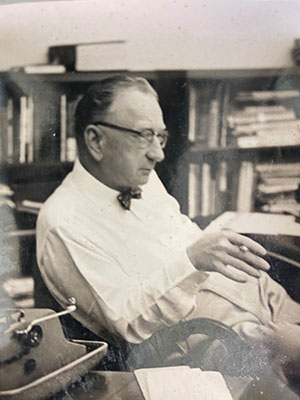
In the months before Nick’s death, H.T. “Ted” Enns returned to Fort Pierce in November 1948, buying an interest in the News-Tribune and becoming publisher, with Paul returning to his role as business manager. After leaving Fort Pierce in 1928, Ted had worked in radio for media owner Gardner Cowles in Des Moines and later New York as his national sales manager.
Ted’s daughter, Susan Enns Tully of Lake Placid, said recently that her father had longed to return to a smaller media market and run his own company. Ted was far more comfortable in the role of publisher than Paul and fully involved himself in the community. He also had a column called In This Corner.
Yet another Enns arrived at the newspaper in 1951. It was my dad, Bob, who had just graduated from Florida State University with an English degree. His college journey was circuitous, with stops at Tulane University, the University of Florida and more than a year in Korea with the Army.
He started at the News-Tribune as a proofreader and then became a sports reporter and sports editor and had a column called Sports Whirl. Working on a general assignment story in 1952, he interviewed the county’s first speech therapist, Katie Duster, who had just arrived from Iowa. By the end of the interview, my dad asked her out for a date. They married in 1954 and later had eight children, of which I was the fourth.
Also in 1954, Paul and Ted sold their interests in the News-Tribune to the owners of the Clearwater Sun newspaper on Florida’s west coast. Under the sale, Ted and Paul remained on with the newspaper as publisher and business manager, an arrangement that would continue through the decade. Nevertheless, the sale meant the News-Tribune would no longer be a locally owned or family-owned newspaper. The sale became a sign of the times, as more independent family-owned newspapers were being sold to groups or chains.
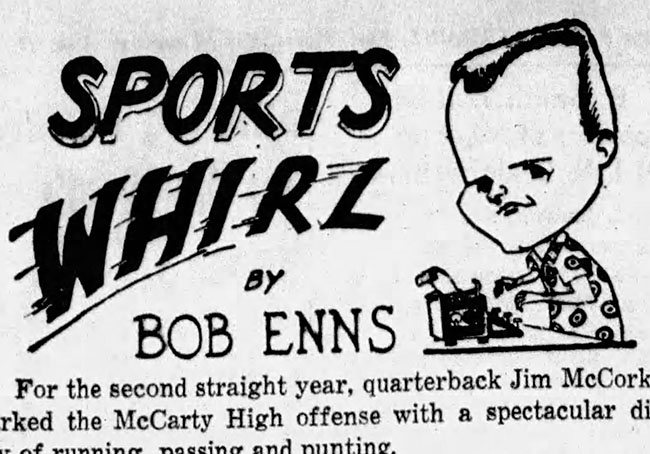
ANOTHER NEW EMPLOYEE
In 1956, Ted got a call from his old boss, Gardner Cowles. Cowles’ daughter, Lois, had married John R. “Jack” Harrison, a 1955 graduate of Harvard University who was interested in the newspaper business but had no experience. Cowles asked Ted to give his son-in-law a job. Ted complied.
Cowles was president of Cowles Magazines and Broadcasting Inc., based in New York. The company owned Look magazine, which at the time had nearly 4 million subscribers. Cowles was also president of the Des Moines Register and Tribune, Iowa’s largest paper. Cowles had a vacation home on Miami Beach and had recently visited his old pal Ted Enns. He was familiar with the area, having purchased some 6,000 acres to create the River Park subdivision in what would become Port St. Lucie. He later sold it to General Development Corp., where he became chairman of the board.
The job Harrison got at the Fort Pierce newspaper was as an entry-level position in the composing room called a printer’s devil. The pay was $40 a week. “Harvard told me you’re ruining the [salary] curve,” said Harrison, who would later become a member of the school’s Board of Overseers.
Gardner Cowles had big plans for his son-in-law. Harrison said his father-in-law had persuaded Ted Enns to allow him to work in various departments in the News-Tribune to learn the newspaper business inside and out. He presumed the union at the Cowles-owned Des Moines Register wouldn’t have allowed such a practice. Harrison stayed at the News-Tribune for more than a year, working in the pressroom, composing room, newsroom and circulation and advertising departments.
He left in late 1957 to work as a business analyst for Look magazine in New York. Before he left, he tipped off Look about two sisters, the step-granddaughters of Amelia Earhart, who were having a double wedding in Fort Pierce. The magazine devoted four pages to the wedding of Sally Putnam to Jack Chapman, the Harrisons’ best friends in Fort Pierce, and Binney Putnam to Joseph Dudley in its Sept. 17, 1957 edition.
NEW OWNERS
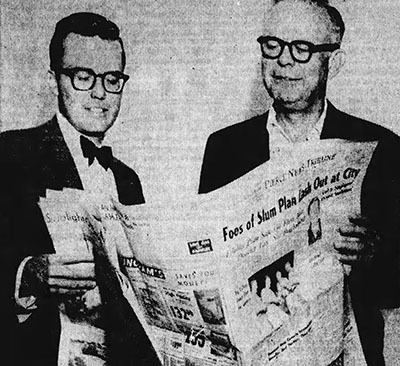
As 1960 approached, Ted Enns, 60, suffering health problems, and Paul Enns, 75, were looking at retiring. At the same time, the Clearwater Sun was considering selling the News-Tribune. Cowles got word the paper was for sale and purchased it in the spring of 1959 for $1 million, about $10.5 million in today’s dollars.
To run the paper, Cowles had his son-in-law Harrison return to Fort Pierce to take on the role of publisher as Ted Enns retired. When the sale was closed in May 1959, Harrison was named associate publisher, becoming publisher when Ted Enns retired Jan. 1, 1960. Westley Stout of the Fort Lauderdale News wrote in a November 1959 column that Cowles purchased the News-Tribune “presumably for his son-in-law John R. Harrison. Cowles himself scarcely could have any interest in owning a small town daily.”
Harrison, 26, indeed had no experience as a publisher, and Cowles asked Paul Enns to remain part-time as business manager to help Harrison learn the ropes.
“I said, ‘I’m not prepared to be publisher,’” Harrison remembered telling his father-in-law. “Mr. Cowles said, ‘That’s okay. I know you’ll make mistakes.’ But when he bought the paper, he asked Paul, ‘Will you stay on half days and mentor the kid and keep him in line?’ It worked out wonderfully for me because Paul really knew the newspaper business.”
Paul stayed on as a coach to Harrison until finally retiring in 1962. “Paul was a terrific guy,” said Harrison, now 90 and living in Osprey, south of Sarasota. “He was a wonderful mentor to me.” Harrison said his greatest mentor was Cowles, known by his friends as Mike. Harrison said he could never come to address his father-in-law casually. Instead, he addressed him as Sir or Mr. Cowles and referred to him as The Boss.
“In 90 years I have never known of a mentor like Gardner Cowles was to me,” Harrison said. “I was his Pygmalion. He was the single most influential individual in my life.”
As Jack and Lois Harrison returned to Fort Pierce in 1959, my parents asked them a question. Would they be godparents to their new baby? The Harrisons agreed, and stood as godparents at my baptism at the old St. Anastasia Catholic Church on Orange Avenue late that spring.
The year I was born, my dad was named managing editor of the News-Tribune. He was named executive editor in 1963, replacing longtime editor Charles Miley, and held that position until 1988. He was editor emeritus until his death in 1990 at the age of 63.
During Freedom Newspapers’ ownership of the paper he had become an avowed libertarian and a quote from one of his columns appeared daily on the paper’s masthead for several years after his death: “We believe in free enterprise, the free market, freedom of expression, freedom of choice, free thought, voluntarism and the freedom to succeed or fail.”
Before his final retirement, Paul gave Harrison one bit of advice. The Okeechobee News building had recently burned down and the owner, LaMonte Moore, wanted to sell it. Paul suggested that Cowles buy it, predicting that Okeechobee would one day be “the Chicago of the South.”
Based on Paul’s recommendation, Harrison persuaded his reluctant father-in-law to buy the paper for the agreed-upon price of $50,000. After six months of operating the paper, it posted no profit, and Harrison and Cowles had resigned themselves to having made a bad business decision.
When Harrison got a visit one day in his Fort Pierce office from a man from Okeechobee who wanted to buy the Okeechobee News for $75,000, he called Cowles in his New York office and let him know he had a man in the lobby who had just made him an offer for the paper. Cowles’ response? “Jack, get off the g— d— phone now and don’t let that guy out of the building.”
The sale netted Cowles a short-term profit of $250,000 in today’s dollars. Cowles had Harrison share his success story at the next American Newspaper Publishers Association meeting in a session attended by New York Times Publisher Arthur Ochs Sulzberger Sr., Washington Post Publisher Katharine Graham and others.
During his time in Fort Pierce, Harrison explored the purchase of other Florida newspapers and persuaded Cowles to buy the Gainesville Sun in 1962. Harrison subsequently moved to Gainesville, where he won a Pulitzer Prize for editorial writing in 1965. From Gainesville, he oversaw the Fort Pierce paper for Cowles and persuaded Cowles to purchase the Lakeland Ledger in 1966 and the Ocala Star-Banner in 1969. Harrison moved to Lakeland in 1966.
Cowles Communications Inc., as the company became known, in 1970 sold the three Florida newspapers, Family Circle magazine and Memphis television station WREC-TV and other publishing assets to the New York Times Company in a deal that gave Cowles Communications $50 million in New York Times stock.
With the transfer of the papers, Harrison became an employee of the New York Times Co., continuing to oversee the three Florida papers. He was named a New York Times vice president in 1971. Using the three Florida newspapers as a foundation, Harrison created the New York Times Regional Newspaper Group and began an acquisition campaign for the company. As group president, Harrison moved the division’s headquarters to Atlanta and grew the division to a collection of 36 newspapers in seven southeastern states and California. He retired in 1993.
Later called the New York Times Regional Media Group, the division was sold in 2012 for $143 million, having shrunk to 16 newspapers as the New York Times Co. refocused its efforts on the growth of its core business, The New York Times newspaper and newyorktimes.com.
Harrison said the New York Times Regional Newspaper Group might never have been created if it weren’t for his tours at the News-Tribune, which exposed him and Cowles to the profitability of Florida’s small newspaper market and later resulted in Cowles buying three additional papers.
The News-Tribune never became part of the New York Times group. Harrison said Cowles wanted television station WESH in the Orlando-Daytona market owned by Perry Communications and Perry, which owned the Palm Beach Post, wanted the nearby News-Tribune. The two media properties changed hands in 1966.
California-based Freedom Newspapers then purchased the News-Tribune from Perry in 1969. The newspaper’s name was simply changed to The Tribune in 1988 and eventually became the St. Lucie News Tribune, its name today. Freedom owned the paper until 2000, when it was sold to the E.W. Scripps Company, which had owned the Stuart News since 1965 and purchased the Vero Beach Press Journal in 1997. While retaining their names, the three newspapers were combined into one regional operation, which has been owned by Gannett Co. since 2016. The three editions of the paper are now printed in Deerfield Beach.
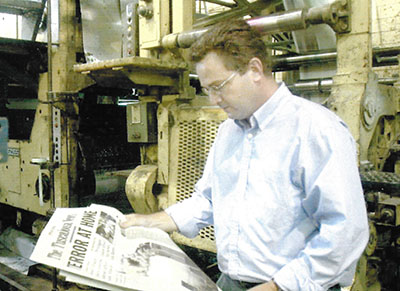
The News-Tribune moved from Atlantic Avenue to 1102 S. U.S. 1 in 1960 in a building that had been expanded to accommodate the press and then to a new building at Edwards Road in 1984. With the consolidation of the Vero, Stuart and Fort Pierce newspapers, the Edwards Road building was sold and for several years no newspaper office was in the county. Gannett in 2022 opened a new office in Fort Pierce, in the old St. Lucie County Bank Building on Second Street and Avenue A, returning the newspaper to downtown after 62 years. The original News-Tribune deco building at 117 Atlantic Avenue still stands, now the home of Healthy Kids of St. Lucie County.
I worked as a reporter at the News-Tribune during summer breaks from college in 1978 and other stints over the years before working there full-time in 1983 and 1984. My sister, Catherine, had also worked there as a reporter and brother, Michael, as a photographer. Together we represented the fourth generation of Ennses who worked at the paper.
Lucky for us, then-owner Freedom Newspapers didn’t have an anti-nepotism policy. Regardless, I’d like to think our contributions were worthwhile, and at least in my own case I suspect I was paid less than my non-family colleagues.
I left the News-Tribune in 1984 to work at the Sarasota Herald-Tribune, which had recently been acquired by the New York Times Regional Newspaper Group. I got the job on my own merits and without the help of Jack Harrison. Except for a five-year stint at the St. Petersburg Times, now Tampa Bay Times, I was with the company until 2006, when I left as managing editor of The Tuscaloosa News and returned to the Treasure Coast to start Indian River magazine.
At Tuscaloosa, the New York Times Co. had begun an initiative to place lifestyle magazines in some of its markets, and I learned about the magazine business by launching Tuscaloosa magazine there. I then conceived of the idea to have my own magazine and started Indian River here with my childhood friend, Allen Osteen, president of East Coast Lumber.
It was because of the New York Times Regional Newspaper Group experience that I started Indian River. Thus, without that newspaper group, which Harrison founded based on his experiences learning the small newspaper business in Fort Pierce, I probably would never have been exposed to the magazine business or gotten the motivation to launch Indian River and continue the Enns family publishing tradition on the Treasure Coast, which began 94 years ago.
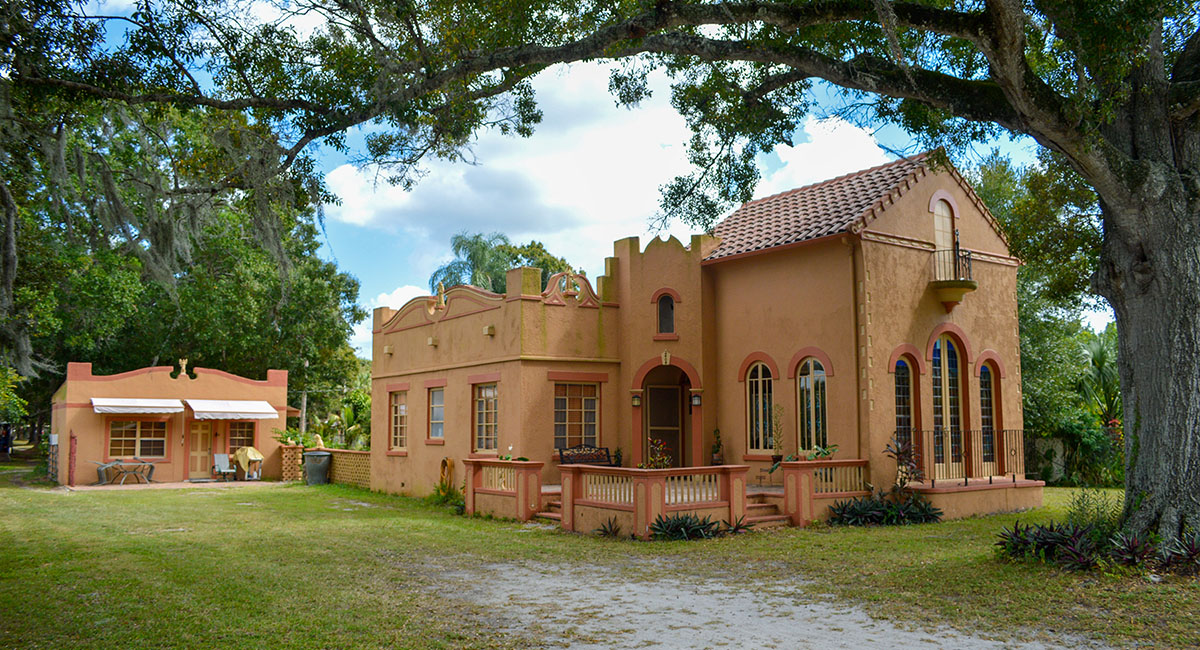
HINTS OF MARAVILLA
If you drive along Sunrise Boulevard today you can see remnants of the old Maravilla in the small Spanish Colonial-style bungalows sandwiched between ranch-style homes.
Still, hints remain of what was envisioned for Maravilla. One of the best examples of the original Maravilla homes still standing is the Jules Frere house at 2404 Sunrise Blvd. Begun in 1926 and completed in 1931, it was designed and built by Frere, owner of Acme Lumber Co. The house features a complex roof line and tile roof, stucco walls and a parapet, niches and a balconette. The house was placed on the National Register of Historic Places in 1995.
The Maravilla golf course is long gone, but a road paralleling Sunrise Boulevard to the east, Fairway Drive, harkens to the development’s past life and gives an indication of the golf course’s approximate location. Other names related to the Maravilla days include Maravilla Boulevard, Club Drive and Keystone Terrace.
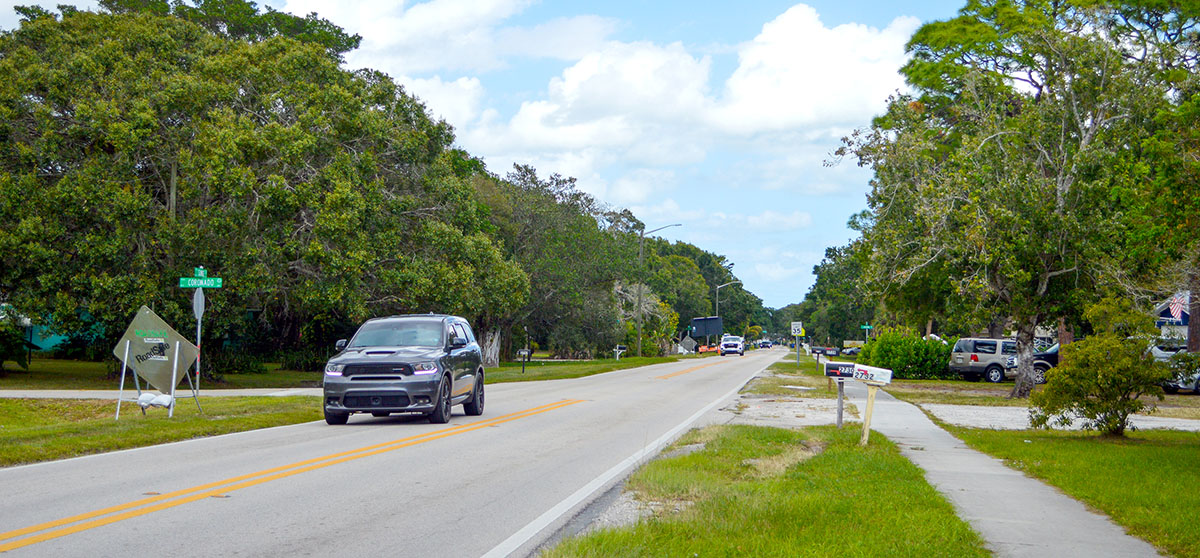
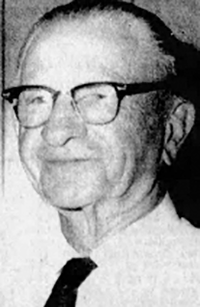
Maravilla founder Paul Enns lived a long life and enjoyed an active retirement playing golf. On his 90th birthday, the family held a big party for him with my dad and staff creating a mock newspaper for the occasion with the banner headline, “Enns patriarch Paul a nifty 90.”
As a teen, I sometimes drove my grandparents around town and remember visiting Paul and Helen at their home in Maravilla south of Edwards Road. Paul’s eyesight was failing and he gave up golf on his 90th birthday and soon had to give up driving and move from Maravilla to a mobile home community on U.S. 1 across from their son, Harkie, and his wife, Randy.
When Helen went into a nursing home, I would occasionally pick up Paul to drive him to visit her. When I’d enter his house, Paul was often standing over a large contraption that he had purchased to magnify the newspaper so that he could continue reading it, despite his failing eyesight. The longest living and last of the original Enns brothers, he died in 1981 at the age of 95. Helen died in 1985 at 90.
Their son Harkie, who worked at the News-Tribune and other papers before becoming a CPA, died in 1995 at the age of 78. He was the father of three daughters, including Mari-Lynn Enns Herringshaw of Fort Pierce.
Paul’s old partner in the newspaper business, his nephew H.T. “Ted” Enns, suffering long-term heart problems, was one of Dr. Michael DeBakey’s first heart transplant patients. He died in 1973 at the age of 74.
The nephew who first arrived in Florida in 1923 with Paul Enns and Nick Enns, my grandfather, Putz, died in 1983 at the age of 82. My grandmother died in 1984 at 81. Charlotte Enns died in 1991 at the age of 89. My uncle, Eddie, died in 2006 at the age of 72.
The oldest relative remaining from my father’s generation is my aunt, Susan Enns Stans, 80, who lives at Lynmoore at Lawnwood assisted living in Fort Pierce. She has helped me fill in details for this story, which is based mostly on what else?
Newspaper accounts.
Gregory Enns is president and owner of Indian River Media Group, publisher of Indian River Magazine. Reach him here.
See the original article in print publication
Nov. 2023
